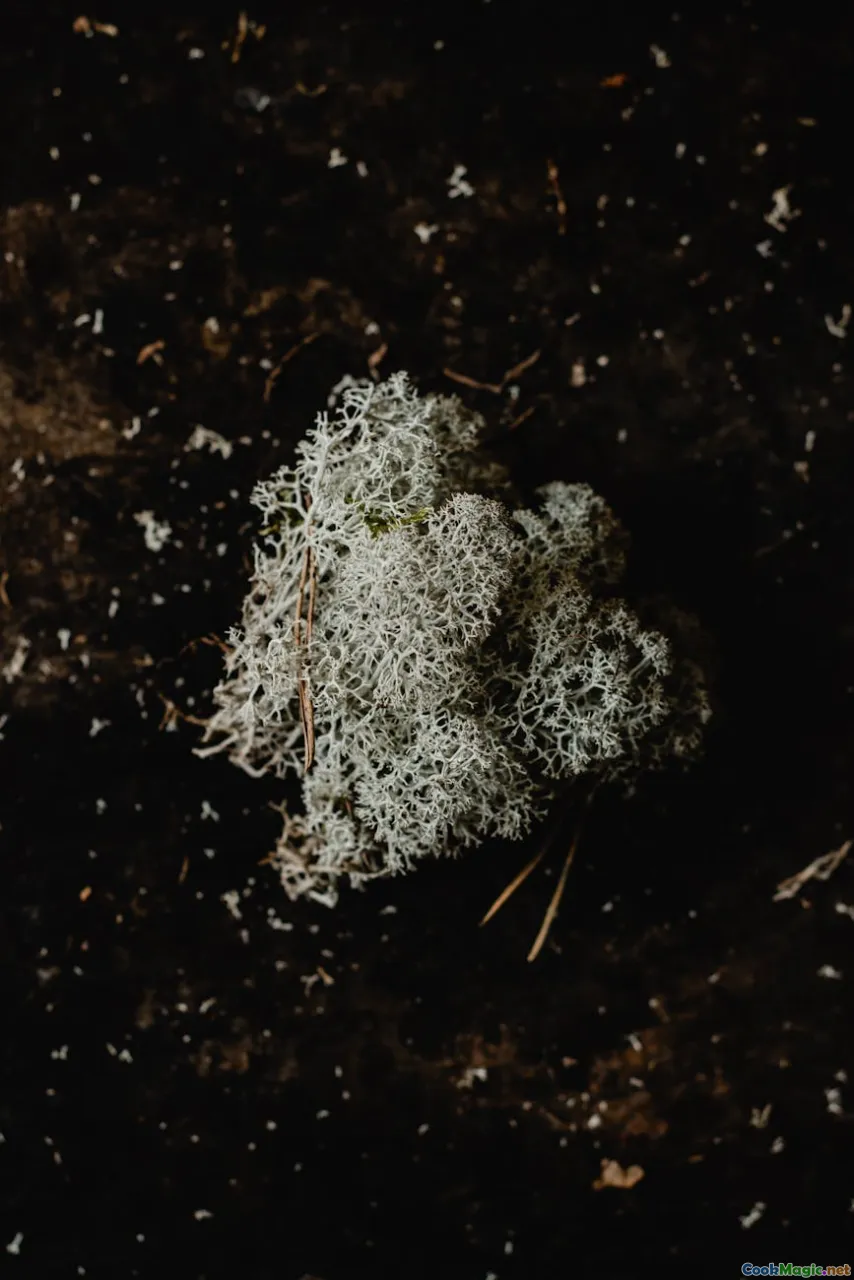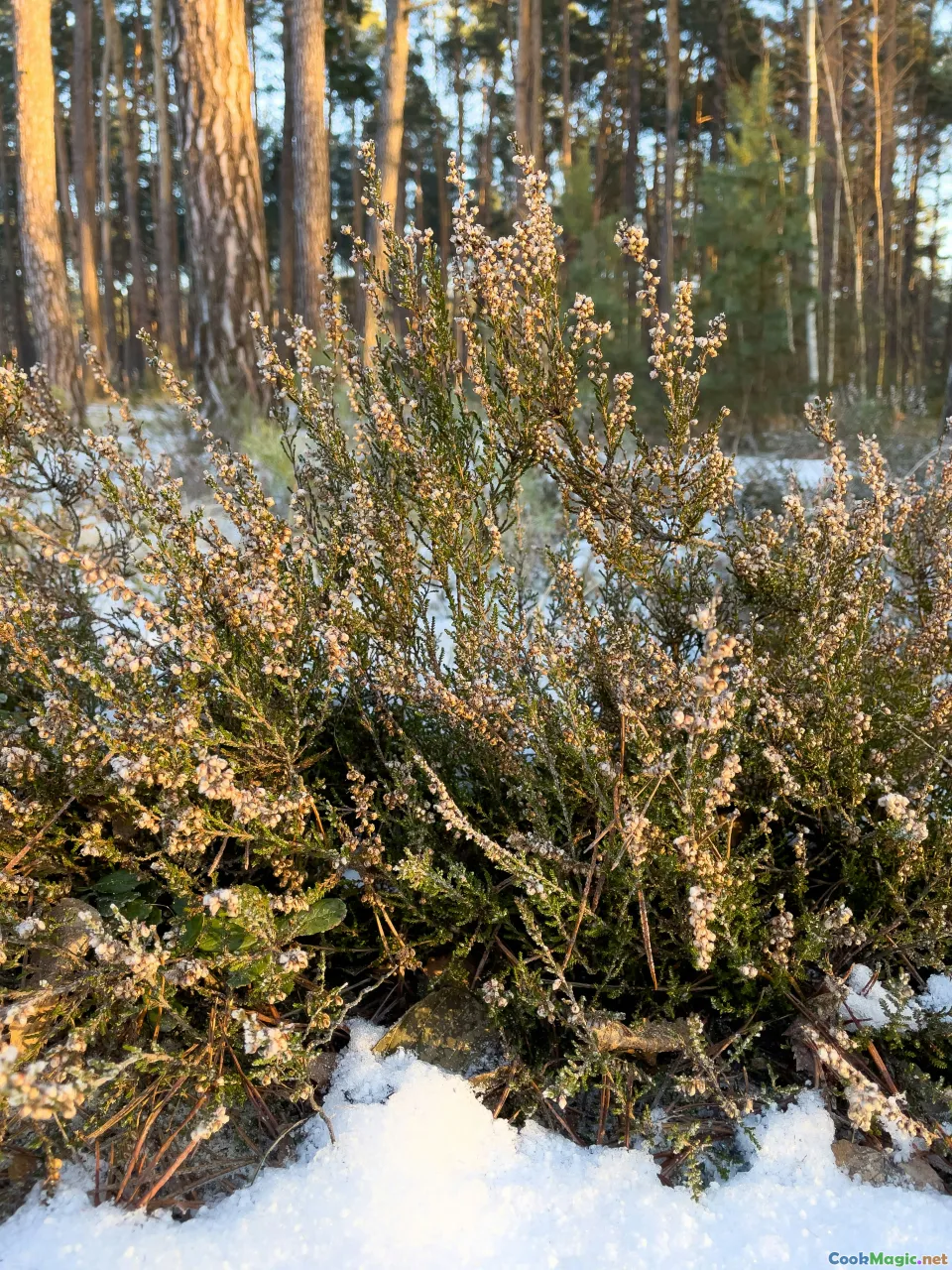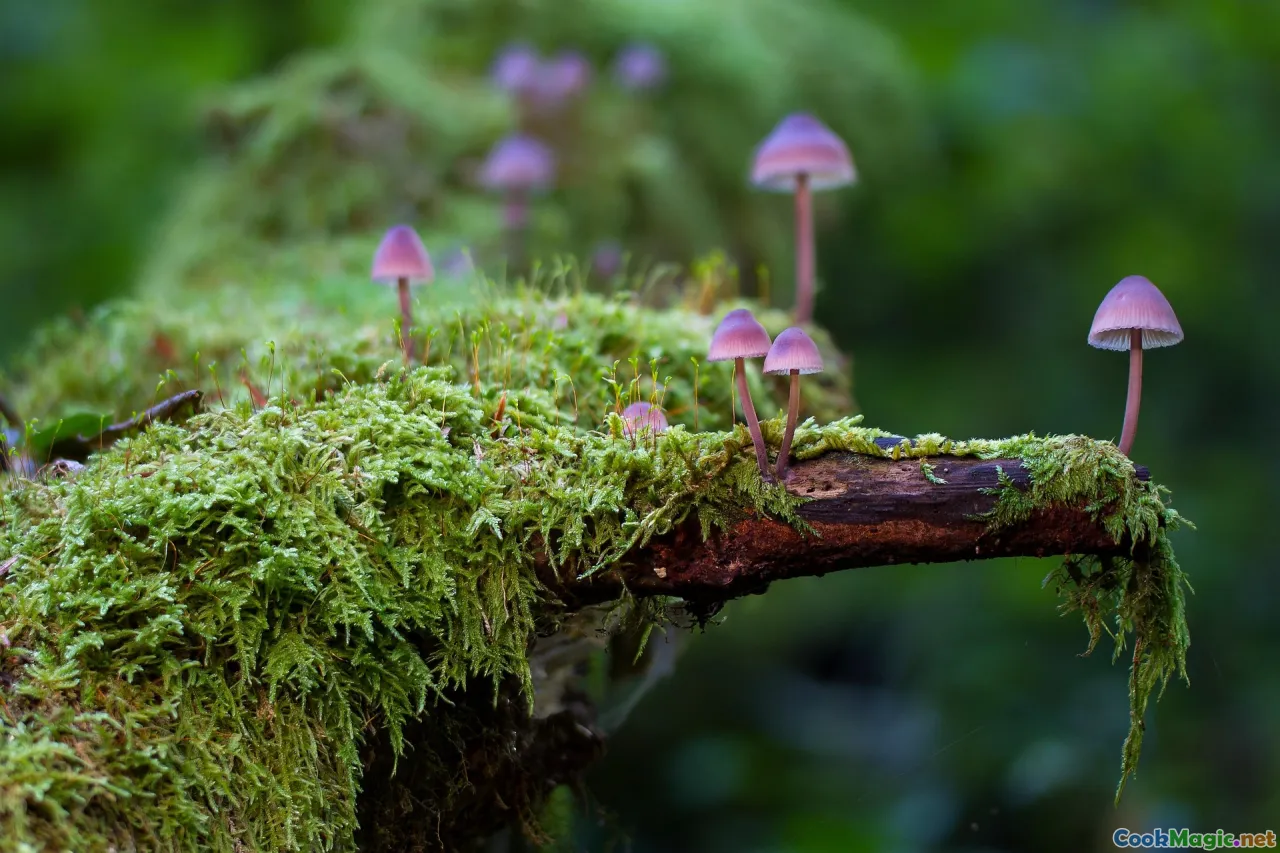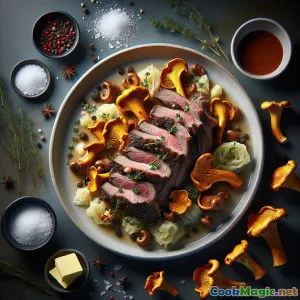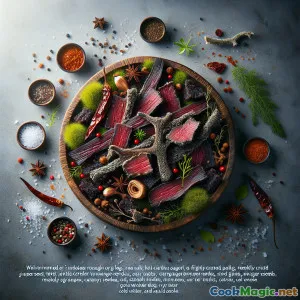
Khô thịt tuần lộc Bắc Âu với rêu tundra được hái từ vùng tundra
(Nordic Reindeer Jerky with Foraged Tundra Moss)
(0 Đánh giá)0
4
tháng 11 02, 2025
Báo cáo sự cố
Nguyên liệu
-
1000 grams Reindeer round or leg, well-trimmed
(Partially freeze for cleaner slicing; venison or beef top round works too)
-
20 grams Reindeer lichen (Cladonia rangiferina), dried
(Also called reindeer moss; must be thoroughly leached and boiled to remove bitterness)
-
18 grams Muối biển
(About 1.8% of meat weight)
-
25 grams Đường nâu
(Balances salt and smoke)
-
2.5 grams Prague Powder #1 (curing salt)
(Use precisely (0.25% of meat). Optional if preheating meat to 71°C/160°F before drying)
-
2 tsp Tiêu đen, mới xay
(Điều chỉnh theo khẩu vị)
-
1 tsp Quả bách xù, nghiền nhẹ
(Classic Nordic piney aroma)
-
3 cloves Tỏi (băm nhỏ)
(Tươi để có hương vị tốt nhất)
-
1 tsp Coriander seeds, toasted and crushed
(Citrusy spice lift)
-
0.5 tsp Hạt thì là
(Earthy, Nordic bakery note)
-
0.5 tsp Ớt bột đỏ
(Optional gentle heat)
-
60 ml Soy sauce (or tamari)
(Adds umami depth)
-
30 ml Giấm táo
(Tenderizes and brightens)
-
15 ml Birch syrup (or maple syrup)
(Northern forest sweetness)
-
30 ml Aquavit (or rye whisky)
(Helps extract spice aromas; evaporates during drying)
-
120 ml Nước lạnh
(Extends marinade for even coverage)
-
1 tsp Vỏ chanh bào mịn
(Adds clean, bright finish)
-
0.5 tsp Liquid smoke
(Use only if not smoking over wood)
(Partially freeze for cleaner slicing; venison or beef top round works too)
(Also called reindeer moss; must be thoroughly leached and boiled to remove bitterness)
(About 1.8% of meat weight)
(Balances salt and smoke)
(Use precisely (0.25% of meat). Optional if preheating meat to 71°C/160°F before drying)
(Điều chỉnh theo khẩu vị)
(Classic Nordic piney aroma)
(Tươi để có hương vị tốt nhất)
(Citrusy spice lift)
(Earthy, Nordic bakery note)
(Optional gentle heat)
(Adds umami depth)
(Tenderizes and brightens)
(Northern forest sweetness)
(Helps extract spice aromas; evaporates during drying)
(Extends marinade for even coverage)
(Adds clean, bright finish)
(Use only if not smoking over wood)
Dinh dưỡng
- Khẩu phần: 10
- Kích thước khẩu phần: 4–5 strips (40g)
- Calories: 180 kcal
- Carbohydrates: 0 g
- Protein: 27 g
- Fat: 4 g
- Fiber: 1 g
- Sugar: 4 g
- Sodium: 880 mg
- Cholesterol: 65 mg
- Calcium: 40 mg
- Iron: 3.8 mg
Hướng dẫn
-
1 - Chill and trim the meat:
Place the reindeer in the freezer for 30–45 minutes until firm at the edges. Trim away silverskin and excess fat for cleaner drying and texture.
-
2 - Slice for desired chew:
Slice 3–5 mm thick. With the grain yields chewier traditional jerky; across the grain gives a more tender bite. Keep slices uniform for even drying.
-
3 - Leach and parboil the lichen:
Rinse lichen in several changes of cold water to remove grit. Soak 15 minutes, then boil in abundant water for 10 minutes. Drain, rinse, repeat a second 10-minute boil. Squeeze dry and roughly chop.
-
4 - Toast Spices:
Toast coriander and caraway in a dry pan on low heat until fragrant, 60–90 seconds. Cool, then crush with juniper to release oils.
-
5 - Mix the marinade:
Whisk soy, water, vinegar, birch syrup, aquavit, brown sugar, sea salt, curing salt (if using), garlic, pepper, crushed spices, chili, lemon zest, and liquid smoke (if using).
-
6 - Combine meat, lichen, and marinade:
Toss sliced meat and chopped lichen with the marinade until every surface is coated and lichen is evenly dispersed.
-
7 - Marinate under refrigeration:
Cover and refrigerate 8–12 hours, turning occasionally for even uptake. Keep below 4°C/40°F at all times.
-
8 - Optional heat-prep for safety:
If you skipped curing salt, preheat meat to 71°C/160°F in a 90–95°C/195–205°F oven for 10–15 minutes until strips reach temp, then proceed to drying.
-
9 - Drain and arrange:
Drain slices, blot dry, and lay on dehydrator trays or wire racks over baking sheets. Avoid overlap; nestle a few lichen strands onto each strip.
-
10 - Dry low and steady:
Dehydrate at 70°C/160°F with good airflow for 4–6 hours. Rotate trays halfway. Jerky should feel dry but still pliable, not brittle.
-
11 - Condition and cool:
Cool strips to room temperature, then place loosely in a jar or bag for 24 hours, shaking to distribute any residual moisture for even texture.
-
12 - Test and store:
Tear a piece—fibers should show and no moisture beads should appear. Store airtight up to 2 weeks at room temp (cool, dark), 1–2 months refrigerated, longer if frozen.
-
13 - Optional smoke finish:
For a campfire note, cold-smoke finished jerky with alder or birch for 20–30 minutes, keeping product temperature under 32°C/90°F.
Place the reindeer in the freezer for 30–45 minutes until firm at the edges. Trim away silverskin and excess fat for cleaner drying and texture.
Slice 3–5 mm thick. With the grain yields chewier traditional jerky; across the grain gives a more tender bite. Keep slices uniform for even drying.
Rinse lichen in several changes of cold water to remove grit. Soak 15 minutes, then boil in abundant water for 10 minutes. Drain, rinse, repeat a second 10-minute boil. Squeeze dry and roughly chop.
Toast coriander and caraway in a dry pan on low heat until fragrant, 60–90 seconds. Cool, then crush with juniper to release oils.
Whisk soy, water, vinegar, birch syrup, aquavit, brown sugar, sea salt, curing salt (if using), garlic, pepper, crushed spices, chili, lemon zest, and liquid smoke (if using).
Toss sliced meat and chopped lichen with the marinade until every surface is coated and lichen is evenly dispersed.
Cover and refrigerate 8–12 hours, turning occasionally for even uptake. Keep below 4°C/40°F at all times.
If you skipped curing salt, preheat meat to 71°C/160°F in a 90–95°C/195–205°F oven for 10–15 minutes until strips reach temp, then proceed to drying.
Drain slices, blot dry, and lay on dehydrator trays or wire racks over baking sheets. Avoid overlap; nestle a few lichen strands onto each strip.
Dehydrate at 70°C/160°F with good airflow for 4–6 hours. Rotate trays halfway. Jerky should feel dry but still pliable, not brittle.
Cool strips to room temperature, then place loosely in a jar or bag for 24 hours, shaking to distribute any residual moisture for even texture.
Tear a piece—fibers should show and no moisture beads should appear. Store airtight up to 2 weeks at room temp (cool, dark), 1–2 months refrigerated, longer if frozen.
For a campfire note, cold-smoke finished jerky with alder or birch for 20–30 minutes, keeping product temperature under 32°C/90°F.
Thông tin thêm về: Khô thịt tuần lộc Bắc Âu với rêu tundra được hái từ vùng tundra
Summary
Tundra Moss Reindeer Jerky blends time-honored northern preservation with forager’s flair. Lean reindeer, sliced thin and marinated with juniper, birch syrup, and a whisper of aquavit, dries into resilient, flavorful strips meant for travel and toil. The distinctive twist is reindeer lichen—often called reindeer moss—carefully leached and parboiled to remove bitterness, then tucked onto each strip so it dries into a delicate, foresty lace. The result is a portable, high-protein snack that tastes of pine wind, smoke, and stone—an homage to Sámi reindeer culture and Nordic pragmatism.
Tips & Notes
- Meat choice and slicing: Reindeer is traditional; venison or beef top/eye of round are reliable substitutes. Slice with the grain for a chewier, classic bite or across for a more tender texture. Aim for 3–5 mm thickness for even drying.
- Lichen safety: Reindeer lichen (Cladonia rangiferina) is edible only after thorough leaching and boiling to reduce bitterness and remove acids. Do not substitute random mosses or lichens; many are not edible. Forage away from roads and polluted areas, and harvest sparingly.
- Cure vs. heat step: If you use curing salt (Prague Powder #1) at correct proportions, you can dry directly at 70°C/160°F. If you prefer to skip curing salt, preheat the strips to 71°C/160°F in a low oven before dehydrating; this step boosts safety without nitrites.
- Drying cues: Properly dried jerky bends and cracks but does not snap. When torn, you should see fibrous strands without visible moisture. If any surface beads appear, continue drying and re-check.
- Conditioning: After drying, place jerky loosely in a jar or bag and rest 24 hours at room temperature, shaking occasionally. This equalizes any lingering moisture to prevent mold and ensure even chew.
- Storage: Airtight at cool room temperature, it lasts up to 2 weeks (longer if cured and very dry). Refrigeration extends to 1–2 months; freezing gives several months without significant quality loss. Always inspect for off odors or visible mold.
- Flavor variations: Swap birch syrup for spruce-tip syrup, add wild blueberries to the marinade for a fruit-wood note, or finish with a light alder smoke. A hint of caraway evokes Nordic rye; coriander adds citrusy lift.
History & Cultural Significance
Reindeer husbandry has long anchored Sámi livelihood across northern Norway, Sweden, Finland, and the Kola Peninsula. Meat was preserved to survive lean months and long migrations, with wind-drying and smoking as practical methods before modern dehydrators. Juniper, an evergreen mainstay, adds both flavor and a sense of the boreal. Incorporating reindeer lichen carries symbolic weight: it is the winter forage that sustains the animals themselves. While people traditionally favored fish, meat, and berries for drying, reindeer lichen has historically been processed as a famine or trail food—boiled, rinsed, sometimes baked into breads. Here, it becomes a textural and aromatic accent, a gentle, crackly veil over each strip that tastes like the landscape.
Unique Aspects
- Textural duality: The jerky’s bounce-meets-snap is contrasted by the lichen’s delicate crispness.
- Aromatic map: Juniper, coriander, and a touch of aquavit sketch a flavor compass of the north—resin, citrus, and spice.
- Field-ready: Lightweight, nutrient-dense, and stable, it’s built for trekking, skiing, and long drives across quiet, snowy kilometers.
Technique Highlights
- Uniform thickness and airflow are everything. Space strips well and rotate trays for consistency.
- Balance salt, acid, and sweet. A modest sugar helps browning and chew without turning the jerky sticky.
- If oven-drying, prop the door slightly ajar with a wooden spoon to promote airflow. A fan-assisted oven is a bonus.
Serving Ideas
- Trail snack with a thermos of spruce-tip tea.
- Shaved over warm barley salad with pickled mushrooms.
- With brown cheese, rye crispbread, and a spoon of lingonberry.
Final Thoughts
This jerky is as much a memory of place as it is a recipe. The lichen demands patience and respect; the meat rewards careful slicing and steady heat. When you tear a strip and breathe in juniper and smoke, you taste old knowledge made road-ready—a pocketable postcard from the tundra.

